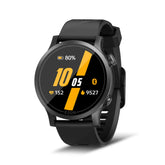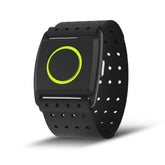The Science of Reverse Taper: Optimize Race Performance with Digital Tools
Unlocking peak race performance requires more than just hard training—it demands strategic tapering. The reverse taper strategy redefines traditional rest periods by reducing training volume while maintaining intensity, guided by data from digital sports watches. This science-backed approach ensures athletes arrive at the starting line fresh, focused, and primed for breakthroughs in marathons, triathlons, and beyond.
1. Reverse Taper vs. Traditional Taper: The Key Difference
A. Traditional Taper: Volume & Intensity Drop
- Classic tapering reduces both training volume (miles, reps) and intensity (pace, weight) over 2–3 weeks, aiming to reduce fatigue.
- Drawback: May lead to detraining, where reduced intensity causes a loss of speed and power.
B. Reverse Taper: Smart Volume Reduction, Sustained Intensity
- Strategy: Cut training volume by 30–50% while maintaining high-intensity work (e.g., interval training, race-pace efforts).
- Science Behind It: Preserves neuromuscular efficiency and lactate threshold while allowing muscle repair, as shown in Journal of Applied Physiology studies.
- Digital Watch Role: Use digital sports watches to track volume metrics (e.g., weekly mileage) and ensure intensity stays within target zones (80–95% of max heart rate).
2. How Digital Tools Drive Reverse Taper Success
A. Training Load Monitoring
- Chronic Training Load (CTL): Watches like the EZON Pro series calculate CTL to gauge cumulative fitness—aim for a 10–15% drop in CTL during reverse taper without crashing.
- Acute Training Load (ATL): Adjust daily workouts to keep ATL stable (e.g., 60–70% of peak training days) to maintain sharpness.
B. Intensity Preservation Tactics
- Interval Workouts: Program your watch to alert for race-pace intervals (e.g., 5x1K at marathon pace with 2-min rest).
- Heart Rate Zones: Ensure high-intensity sessions stay in Zone 4–5 (85–95% MHR) while reducing low-intensity volume (Zone 2–3).
3. Nutrition Strategies for Reverse Taper Periods
A. Carbohydrate Timing
- Carb Loading Phase: 3 days pre-race, increase carbs to 8–10g/kg body weight (e.g., 600g for a 70kg athlete) to maximize glycogen stores.
- Digital Watch Insight: Use calorie burn data from your digital sports watch to adjust carb intake—reduce by 15% if training volume drops by 30%.
B. Protein & Recovery Nutrition
- Daily Protein: Maintain 1.6–2.2g/kg to support muscle repair (e.g., 112–154g for 70kg athlete).
- Post-Intensity Meal: Consume 40g protein + 80g carbs within 30 minutes of hard sessions to optimize recovery.
4. Reverse Taper Training Plan: 2-Week Protocol
Week 1: Volume Reduction, Intensity Hold
| Day | Traditional Taper | Reverse Taper (With Digital Guidance) |
|---|---|---|
| Monday | 10K easy run | 5K easy run + 4x400m at 5K pace (watch-paced intervals) |
| Wednesday | Rest or yoga | 30-min HIIT (Zone 4–5) + mobility work |
| Friday | 15K long run | 10K run at marathon pace (watch alerts for pace consistency) |
Week 2: Tapering to Race Day
-
48 Hours Pre-Race:
- 30-min easy jog at 60% MHR, followed by foam rolling.
- Use watch sleep tracking to ensure 7–9 hours of rest (deep sleep >20% for optimal recovery).
5. Common Mistakes to Avoid
-
Overdoing Intensity:
- Solution: Use your digital sports watch to limit high-intensity sessions to 2–3x/week during taper.
-
Neglecting Hydration:
- Solution: Program watch reminders to drink 200ml water every hour, especially as training volume decreases (sweat loss signals may be lower).
-
Ignoring Recovery Metrics:
- Solution: Monitor heart rate variability (HRV) daily—if HRV drops >10%, reduce next day’s intensity.
6. FAQs: Your Reverse Taper Questions Answered
Q: How does reverse taper differ for short vs. long races?
- Short races (5K/10K): Focus on maintaining speed with 10–20-second sprints. Long races (marathon): Prioritize race-pace endurance intervals.
Q: Can I use a basic fitness tracker for reverse taper?
- Basic trackers work for volume tracking, but digital sports watches with heart rate zones and interval alerts offer precision for intensity management.
Q: When to switch from traditional to reverse taper?
- Ideal for athletes with 6+ months of consistent training. Beginners may benefit more from traditional tapering to avoid overtraining.
Race Ready: Data-Driven Tapering for Peak Performance
The reverse taper strategy, paired with insights from digital sports watches, transforms the pre-race period from passive rest to active performance optimization. By reducing volume while preserving intensity, athletes avoid detraining and arrive at the start line with fresh legs and a sharp competitive edge.
Trust the data, fine-tune your nutrition, and let technology guide your taper. The finish line awaits—train smart, taper strategically, and conquer your next race with confidence.
EZON Watch: Precision Sports Technology for Peak Performance
https://ezonwatch.com
https://ezonwatch.com









